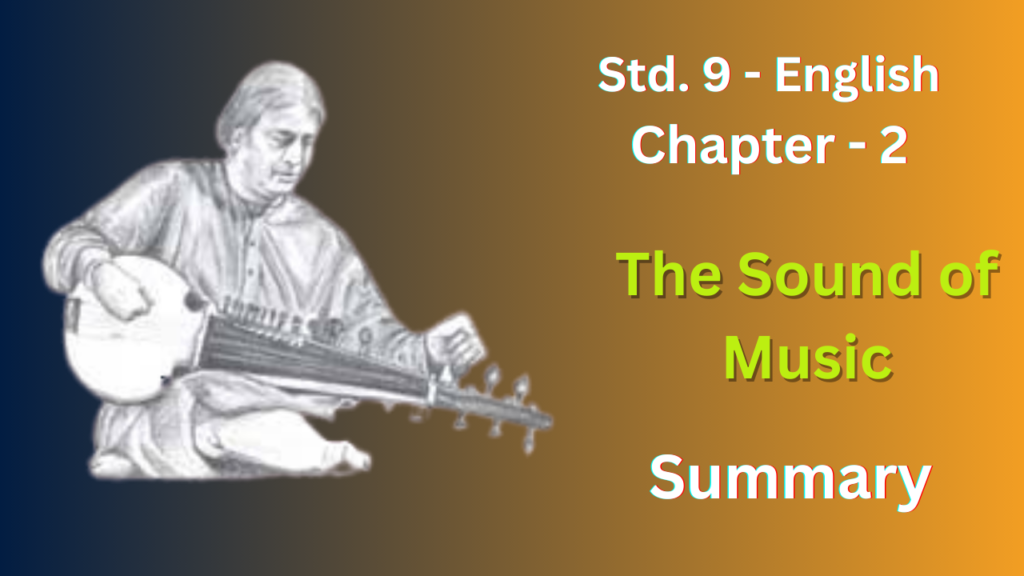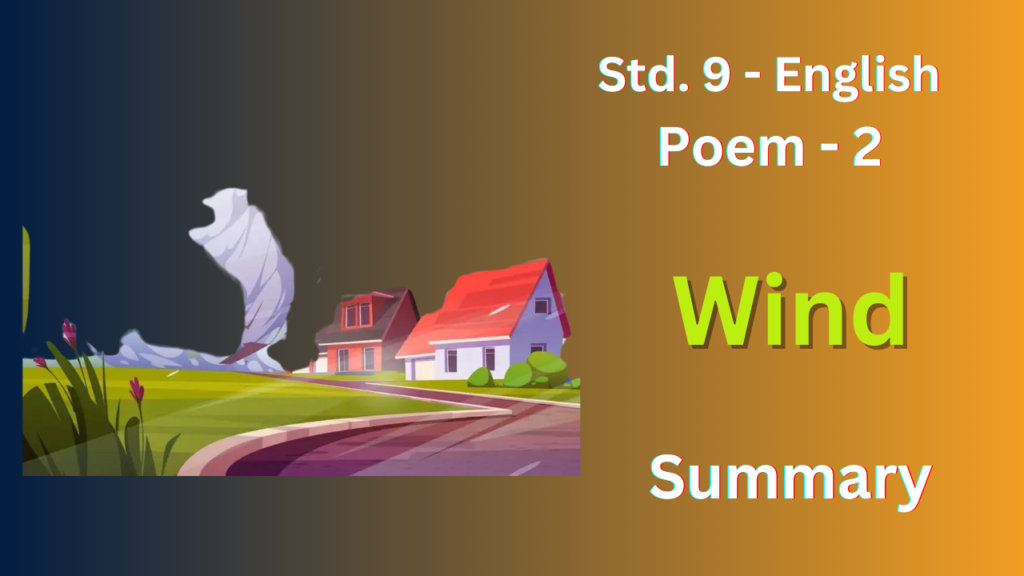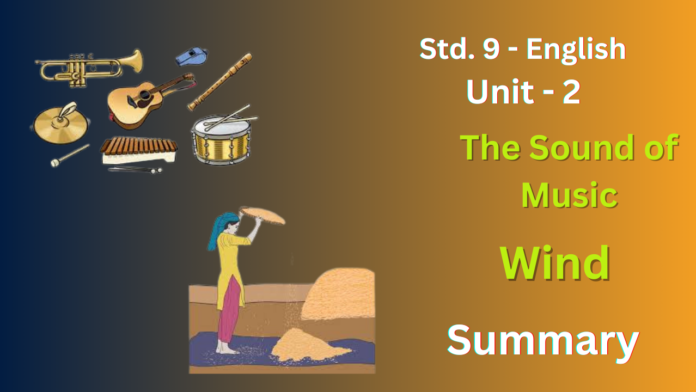NCERT Solutions for Class 9 English Chapter 2
The Sound of Music
The chapter “The Sound of Music” in your 9th-grade English textbook focuses on two exceptional musicians:
Part 1: Evelyn Glennie – The Multi-Percussionist
- Deafness: Evelyn Glennie is a renowned percussionist who is profoundly deaf. She lost her hearing gradually as a child, but this didn’t stop her from pursuing her passion for music.
- Feeling the Music: Evelyn learned to experience music through vibrations and physical sensations. She feels the music through the floor, instruments, and even the conductor’s movements.
- Success: Despite her deafness, Evelyn mastered numerous percussion instruments and achieved international recognition. This section highlights her determination and the unique way she connects with music.
Part 2: Bismillah Khan – The Shehnai Maestro
- Indian Music Legend: Bismillah Khan was a legendary Indian musician known for his mastery of the shehnai, a double-reed instrument.
- Captivating Performances: His captivating performances brought him national and international fame. He is credited with elevating the shehnai from a folk instrument to a revered part of Indian classical music.
- Cultural Significance: This section focuses on Bismillah Khan’s contribution to Indian music and culture.
Overall Contrast:
The chapter showcases two contrasting yet inspiring stories. Evelyn demonstrates how passion and perseverance can overcome challenges, while Bismillah Khan exemplifies the power of music to transcend cultures and bring people together.

NCERT Solutions for Class 9 English Chapter 1
Thinking about the Text
Tick the right answer.
- The (shehnai, pungi) was a ‘reeded noisemaker.’
- (Bismillah Khan, A barber, Ali Bux) transformed the pungi into a shehnai.
- Bismillah Khan’s paternal ancestors were (barbers, professional musi-cians).
- Bismillah Khan leamt to play the shehnai from (Ali Bux, Paigambar Bux, Ustad Faiyaaz Khan).
- Bismillah Khan’s first trip abroad was to (Afghanistan, U.S.A., Canada).
Ans :
- Pungi
- A barber
- Professional musicians
- Ali bux
- Afghanistan
2. Find the words in the text which show Ustad Bismillah Khan’s feelings about the items listed below. Then mark a tick (✓) in the correct column. Discuss your answers in class.
| Bismillah Khan’s feelings about | Positive | Negative | Neural |
| teaching children music | |||
| the film world | |||
| migrating to the U.S.A. | |||
| playing at temples | |||
| getting the Bharat Ratna | |||
| the banks of the Ganga | |||
| leaving Benaras and Dumraon |
Ans :
- Positive
- Negative
- Negative
- Neutral
- Positive
- Positive
- Negative
III. Answer these questions in 30-40 words.
1. Why did Aurangzeb ban the playing of the pungi?
Ans : Aurangzeb, the Mughal emperor, disliked the pungi’s sound. The pungi, a double reed instrument, produces a shrill and rather harsh tone. It seems Aurangzeb found this unpleasant and possibly considered it more of a noisemaker than a musical instrument. Therefore, he banned its playing within the royal court.
2. How is a shehnai different from a pungi?
Ans : A shehnai is a pipe with a natural hollow, longer and broader than a pungi. It has seven holes along its body.
3. Where was the shehnai played traditionally? How did Bismillah Khan change this?
Ans :
Royal courts: It was part of ensembles entertaining royalty.
Temples: Its uplifting tunes accompanied religious ceremonies.
Weddings: The shehnai’s joyful sounds marked celebratory occasions.
4. When and how did Bismillah Khan get his big break?
Ans : Bismillah Khan’s big break arrived in 1938 with the opening of the All India Radio station in Lucknow. This new platform allowed him to showcase his shehnai playing on the radio, reaching a vast audience across India. His talent captured the public’s attention, and he soon became a regular feature on the radio, paving the way for his rise to national fame.
5. Where did Bismillah Khan play the shehnai on 15 August 1947? Why was the event historic?
Ans : On August 15, 1947, Bismillah Khan played his shehnai at the iconic Red Fort in Delhi.This event was historic for two reasons:
India’s Independence: It marked the momentous occasion of India gaining independence from British rule.
Shehnai’s National Significance: Bismillah Khan became the first musician to usher in the newly independent nation with the uplifting music of the shehnai, elevating its status from a primarily celebratory instrument to one that embodied national pride.
6. Why did Bismillah Khan refuse to start a shehnai school in the U.S.A.?
Ans : Bismillah Khan’s refusal to establish a shehnai school in the U.S.A. stemmed from his strong ties to his homeland, India. There are a couple of reasons often cited:
- Deep Attachment to India: He reportedly felt a deep love for his country, particularly his hometown of Benaras, the Ganges River, and Dumraon. Living away from these places wasn’t something he considered.
- Importance of Cultural Context: It’s possible he believed the essence of shehnai playing was intricately linked to Indian culture and traditions. He might have felt the instrument wouldn’t be taught authentically outside its native environment.
7. Find at least two instances in the text which tell you that Bismillah Khan loves India and Benaras.
Ans :
Yearning for Home: The text mentions that whenever Bismillah Khan traveled abroad, he missed “Hindustan” (India) deeply. This indicates a strong emotional connection to his homeland.
Benaras and the Ganges: The passage describes how even while in Mumbai, Bismillah Khan longed for Benaras and the holy Ganges. This highlights his special attachment to his city and the sacred river, symbolizing his love for a specific part of India.
Thinking about language
Look at these sentences.
- Evelyn was determined to live a normal life.
- Evelyn managed to conceal her growing deafness from friends and teachers.
The italicised parts answer the questions:
“What was Evelyn determined to do?” and “What did Evelyn manage to do?” They begin with a to-verb {to live, to conceal). Complete the following sentences. Beginning with a to-verb, try to answer the questions in brackets.
- The school sports team hopes ………….. (What does it hope to do?)
- We all want ………….. (What do we all want to do?)
- They advised the hearing-impaired child’s mother ………….. (What did they advise her to do?)
- The authorities permitted us to ………….. (What did the authorities permit us to do?)
- A musician decided to ………….. (What did the musician decide to do?)
Ans :
- The school sports team hopes to win (the championship/game).
- We all want to be happy (or to live a fulfilling life).
- They advised the hearing-impaired child’s mother to seek professional help (or to learn sign language).
- The authorities permitted us to camp overnight (or to enter the restricted area).
- A musician decided to compose a new symphony (or to learn a new instrument).
2. From the text on Bismillah Khan, find the words and phrases that match these definitions and write them down. The number of the paragraph where you will find the words/phrases has been given for you in brackets.
- the home of royal people (1) …………..
- the state of being alone (5) …………..
- a part which is absolutely necessary (2) …………..
- to do something not done before (5) …………..
- without much effort (13) …………..
- quickly and in large quantities (9) ………….. and …………..
Ans :
- royal residence (Paragraph 1)
- solitude (Paragraph 5)
- indispensable component (Paragraph 2)
- improvise (Paragraph 5) [This might be an inference based on Bismillah Khan’s performance style]
- effortlessly (Paragraph 13)
- thick and fast (Paragraph 9)
3. Tick the right answer.
- When something is revived, it (remains dead/lives again).
- When a government bans something, it wants it (stopped/started).
- When something is considered auspicious (welcome it/avoid it).
- When we take to something, we find it (boring/interesting).
- When you appreciate something, you (find it good and useful/find it of no use).
- When you replicate something, you do it (for the first time/for the second time).
- When we come to terms with something, it is (still upsetting/no longer upsetting).
Ans :
- When something is revived, it lives again.
- When a government bans something, it wants it stopped.
- When something is considered auspicious, it means we should welcome it.
- When we take to something, we find it interesting.
- When you appreciate something, you find it good and useful.
- When you replicate something, you do it for the second time (or more).
- When we come to terms with something, it is no longer upsetting.
Consult your dictionary and complete the following table. The first one has been done for you.
| adjective | only before noun | not before noun | both before and after the verb be |
| indispensable | ✓ | ||
| impressed | |||
| afraid | |||
| outdoor | |||
| paternal | |||
| countless | |||
| priceless |
Ans :
| adjective | only before noun | not before noun | both before and after the verb be |
| indispensable | ✓ | ||
| impressed | ✓ | ||
| afraid | after the verb be | ||
| outdoor | ✓ | after the verb be | |
| paternal | ✓ | ✓ | |
| countless | ✓ | ||
| priceless | after the verb be |
- Impressed: I was incredibly impressed by her dedication to volunteering. (verb phrase)
- Afraid: The child was afraid of the dark. (adjective phrase)
- Outdoor: We enjoyed an outdoor movie screening in the park last night. (adjective phrase)
- Paternal: My grandfather offered me some paternal advice before I left for college. (adjective phrase)
- Countless: Countless stars twinkled in the night sky. (adjective phrase)
- Priceless: The family heirloom was priceless to them, not just for its monetary value but for its sentimental worth. (adjective phrase)
Speaking
Question 1.
Imagine the famous singer Kishori Amonkar is going to visit your school. You have been asked to introduce her to the audience before her performance. How would you introduce her?
Here is some information about Kishori Amonkar you can find on the internet. Read the passage and make notes of the main points about:
- her parentage
- the school of music she belongs to
- her achievements
- her inspiration • awards
Padma Bhushan recipient Kishori Amonkar, widely considered the finest female vocalist of her generation, was bom in 1931. She is the daughter of another great artist, Smt. Mogubai Kurdikar. In her early years she absorbed the approach and repertoire of her distinguished mother’s teacher Ustad Alladiya Khan. As her own style developed, she moved away from Alladiya Khan’s ‘Jaipur-Atrauli Gharana’s style in some respects. As a mature artist her approach is usually regarded as an individual, if not unique, variant of the Jaipur model.
Kishori Amonkar is a thinker. She is besotted by what she calls the mysterious world of her raagas. She dissects them with the precision of a perfectionist, almost like a scientist, until the most subtle of shades and emotions emerge and re-emerge.
She is very much inspired by the teachings of the ancient Vedic sages, written at a time when vocal music was highly devotional in character.
This soul-searching quality of her music, coupled with a very intellectual approach to raaga performance has gained her quite a following in India and has helped to revive the study of khayal.
Significant awards bestowed on this artist include the Sangeet Natak Akademi Award (1985), the Padma Bhushan (1987), and the highly coveted Sangeet Samradhini Award (considered one of the most prestigious awards in Indian Classical Music) in 1997.
Ans :
Good morning everyone, and welcome! Today, we have the extraordinary privilege of hosting a legendary figure in the world of Indian classical music, the one and only Kishori Amonkar.
Born in 1931, Ms. Amonkar comes from a rich musical lineage. Her mother, Smt. Mogubai Kurdikar, was a renowned artist herself. Kishori ji initially trained under the tutelage of Ustad Alladiya Khan, following the traditions of the Jaipur-Atrauli Gharana. However, as her unique style blossomed, she developed a distinct and individual approach, further enriching the Jaipur model.
But Ms. Amonkar is more than just a vocalist. She’s a scholar and a seeker. Deeply fascinated by the complexities of ragas, she dissects them with meticulous precision, revealing their hidden depths and emotions. Inspired by the ancient Vedic philosophy and its devotional essence, she infuses her music with a profound soulfulness.
This unique blend of intellectual exploration and heartfelt devotion has captivated audiences across India. Ms. Amonkar’s dedication has played a significant role in reviving the study of khayal, a cornerstone of Hindustani classical music.
Her remarkable contributions have been recognized with prestigious awards like the Sangeet Natak Akademi Award, the Padma Bhushan, and the coveted Sangeet Samradhini Award.
Now, without further ado, let’s welcome the maestro herself, Kishori Amonkar, who will grace us with her mesmerizing performance!
2. Use your notes on Kishori Amonkar to introduce her to an imaginary audience.Ans : The legendary vocalist Kishori Amonkar graces us today! Trained in the Jaipur tradition, she developed a unique style, renowned for its depth. A scholar of ragas, she unlocks their hidden emotions. Inspired by ancient Vedic music, her performances brim with soulful expression. A champion of khayal revival, she’s a recipient of the Sangeet Natak Akademi Award, Padma Bhushan, and the prestigious Sangeet Samradhini Award. Let’s welcome Ms. Amonkar!
Wind
The poem “Wind” by Subramania Bharati uses the wind as a metaphor for life’s difficulties. Here’s a short summary:
- The wind is portrayed as a powerful and destructive force. It breaks windows, scatters papers, and throws down books.
- The speaker asks the wind to be gentle. This suggests a desire for a less challenging life.
- The wind’s destructive power is linked to the struggles and hardships of life. It can break down the weak, but also strengthen the resilient.
- The poem emphasizes the importance of being strong both physically and mentally to face life’s challenges.
- The final line suggests that those who are weak may not survive the harsh realities of life.

NCERT Solutions for Class 9 English Chapter 1
Thinking about the poem
I
1. What are the things the wind does in the first stanza?
Ans : In the first stanza of “Wind,” the wind is described as acting violently, creating a sense of chaos and destruction. Here’s what it does:
- Breaks shutters: This suggests forceful winds damaging window coverings.
- Rattles windows: The wind’s intensity shakes the windows.
- Scatters papers: Loose papers are blown around in a frenzy.
- Throws down books: Even heavier objects like books are not spared from the wind’s force.
2. Have you seen anybody winnow grain at home or in a paddy field? What is the word in your language for winnowing? What do people use for winnowing? (Give the words in your language, if you know them.)
Ans : Yes, I have seen women winnow grain in my village. People winnow grains to remove straw, chaff, and dust. This process is called ‘Barsana’.
3. What does the poet say the wind god winnows?
Ans : In the poem “Wind” by Subramania Bharati, the poet uses the wind god as a metaphor for life’s challenges
4. How does we make wind our friend?
Ans : The poet suggests that we should build sturdy houses and secure the doors firmly to befriend the wind. Additionally, we should cultivate inner strength to confront life’s challenges.
5. What do the last four lines of the poem mean to you?
Ans : The poem’s ending packs a punch. It suggests the weak won’t survive life’s hardships (wind), but the strong will stand tall. It could also be interpreted as a call to develop strength, as those who haven’t yet might struggle. Overall, it emphasizes facing challenges head-on to become stronger.
6. How does the poet speak to the wind—in anger or with humour? You must also have seen or heard of the wind “crumbling lives”. What is your response to this? Is it same as the poet’s?
Ans : The poet addresses the wind with humor, and I believe this approach is appropriate. I have also witnessed the wind mercilessly destroying property. The poet invites the wind to challenge him, intending to ready himself for the onslaught.
II.
The poem you have just read is originally in Tamil. Do you know any such poems in your language?
Ans : Yes, I know many poems like the one given here.
English: “Ode to the West Wind” by Percy Bysshe Shelley
Japanese: “Fuyu no yoru” (Winter Night) by Matsuo Basho (Haiku)
Spanish: “Viento”
NCERT Solutions for Class 9 English Chapter 1
FAQ’s
What is the main message of the poem “Wind”?
The poem “Wind” conveys the message that one must be strong and resilient to overcome life’s challenges.
How do the NCERT Solutions for Class 9 English Chapter 2 help students?
They provide detailed explanations and answers, helping students understand the poem’s themes and prepare for exams.
What themes are explored in the poem “Wind”?
The poem explores themes of resilience, strength, and the power of nature.
What literary devices are used in “Wind”?
The poem uses personification, metaphor, and imagery.
Where can I find the NCERT Solutions for Class 9 English Chapter 2?
They can be found on educational websites, NCERT’s official site like education85, and various online study platforms.


